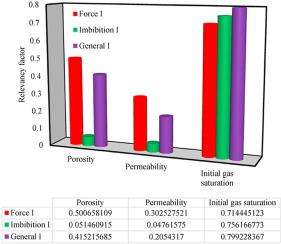当前位置:
X-MOL 学术
›
Gas Sci. Eng.
›
论文详情
Our official English website, www.x-mol.net, welcomes your
feedback! (Note: you will need to create a separate account there.)
Rigorous Framework Determining Residual Gas Saturations During Spontaneous and Forced Imbibition Using Gene Expression Programming
Gas Science and Engineering Pub Date : 2020-12-01 , DOI: 10.1016/j.jngse.2020.103644 Alireza Rostami , Abdelmoneam Raef , Arash Kamari , Matthew W. Totten , Mohammad Abdelwahhab , Ekarit Panacharoensawad
Gas Science and Engineering Pub Date : 2020-12-01 , DOI: 10.1016/j.jngse.2020.103644 Alireza Rostami , Abdelmoneam Raef , Arash Kamari , Matthew W. Totten , Mohammad Abdelwahhab , Ekarit Panacharoensawad

|
Abstract – Aquifer encroachments toward the producing gas zones can substantially decrease the volumetric gas flowrate due to the bypassing of large gas volumes in the porous media. It is well-known that the main parameter monitoring the cumulative gas production is the residual gas saturation; therefore, a complete information about strong aquifer drive gas reservoirs is required relying on both operational and petrophysical parameters. Despite the abundance of studies, attempting to establish comprehensive and adequately precise models for estimating the residual gas saturations is still challenging. In present work, the new method namely, Gene Expression Programming (GEP), was used to propose 9 correlations for force, spontaneous imbibition and the overall waterflood conditions. For this reason, a comprehensive database including 897 residual gas saturation data were adopted from the open source literatures. The variation ranges of the employed dataset include 0.013 to 1 for initial gas saturation, 0.001 to 12950 mD for absolute permeability of rock, 0.008 to 0.494 for porosity (as the input parameters) and 0 to 0.79 for residual gas saturation (as the model output). Numerous types of error analyses such as statistical and visual tools are employed to assess the prediction capability of the new methods developed here as compared with a commonly applied literature model. As a result, it is perceived that the General I, Imbibition I and Force I are the most effective correlations with the root mean square error (RMSE) of 0.09, 0.06 and 0.14, consecutively. The results of the literature model are less efficient than our newly suggested methods. Moreover, the so-called technique of sensitivity analysis revealed that the porosity and permeability have insignificant impacts on predicting the residual gas saturation in the case of spontaneous imbibition. To end with, the results of this study can be the good nominees for fast, accurate and inexpensive estimation of the residual gas saturation especially during reservoir engineering simulation and calculation at the time in which the whole information may not be available to the researches.
中文翻译:

使用基因表达编程确定自发和强制吸入期间残留气体饱和度的严格框架
摘要 – 由于绕过多孔介质中的大量气体,含水层侵入产气区会显着降低气体体积流量。众所周知,监测累计产气量的主要参数是剩余气饱和度;因此,需要依靠操作参数和岩石物理参数来获得关于强含水层驱动气藏的完整信息。尽管有大量研究,但试图建立全面且足够精确的模型来估计残余气饱和度仍然具有挑战性。在目前的工作中,新的方法,即基因表达编程(GEP),被用来提出力、自吸和整体注水条件的 9 个相关性。为此原因,综合数据库包括897个残余含气饱和度数据,采用开源文献。所采用数据集的变化范围包括初始含气饱和度为 0.013 至 1,岩石绝对渗透率为 0.001 至 12950 mD,孔隙度为 0.008 至 0.494(作为输入参数)和残余含气饱和度为 0 至 0.79(作为模型输出) )。与常用的文献模型相比,采用多种类型的误差分析(例如统计和可视化工具)来评估此处开发的新方法的预测能力。因此,我们认为一般 I、Imbibition I 和 Force I 是最有效的相关性,均方根误差 (RMSE) 连续为 0.09、0.06 和 0.14。文献模型的结果不如我们新建议的方法有效。此外,所谓的敏感性分析技术表明,在自吸情况下,孔隙度和渗透率对预测残余气饱和度的影响不显着。最后,这项研究的结果可以成为快速、准确和廉价估计剩余气饱和度的良好提名,特别是在储层工程模拟和计算过程中,在研究可能无法获得全部信息的时候。
更新日期:2020-12-01
中文翻译:

使用基因表达编程确定自发和强制吸入期间残留气体饱和度的严格框架
摘要 – 由于绕过多孔介质中的大量气体,含水层侵入产气区会显着降低气体体积流量。众所周知,监测累计产气量的主要参数是剩余气饱和度;因此,需要依靠操作参数和岩石物理参数来获得关于强含水层驱动气藏的完整信息。尽管有大量研究,但试图建立全面且足够精确的模型来估计残余气饱和度仍然具有挑战性。在目前的工作中,新的方法,即基因表达编程(GEP),被用来提出力、自吸和整体注水条件的 9 个相关性。为此原因,综合数据库包括897个残余含气饱和度数据,采用开源文献。所采用数据集的变化范围包括初始含气饱和度为 0.013 至 1,岩石绝对渗透率为 0.001 至 12950 mD,孔隙度为 0.008 至 0.494(作为输入参数)和残余含气饱和度为 0 至 0.79(作为模型输出) )。与常用的文献模型相比,采用多种类型的误差分析(例如统计和可视化工具)来评估此处开发的新方法的预测能力。因此,我们认为一般 I、Imbibition I 和 Force I 是最有效的相关性,均方根误差 (RMSE) 连续为 0.09、0.06 和 0.14。文献模型的结果不如我们新建议的方法有效。此外,所谓的敏感性分析技术表明,在自吸情况下,孔隙度和渗透率对预测残余气饱和度的影响不显着。最后,这项研究的结果可以成为快速、准确和廉价估计剩余气饱和度的良好提名,特别是在储层工程模拟和计算过程中,在研究可能无法获得全部信息的时候。











































 京公网安备 11010802027423号
京公网安备 11010802027423号